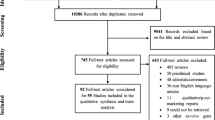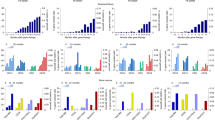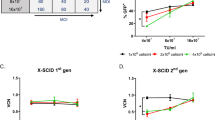Abstract
Foamy virus (FV) vectors are promising for hematopoietic stem cell (HSC) gene therapy but preclinical data on the clonal composition of FV vector-transduced human repopulating cells is needed. Human CD34+ human cord blood cells were transduced with an FV vector encoding a methylguanine methyltransferase (MGMT)P140K transgene, transplanted into immunodeficient NOD/SCID IL2Rγnull mice, and selected in vivo for gene-modified cells. The retroviral insertion site profile of repopulating clones was examined using modified genomic sequencing PCR. We observed polyclonal repopulation with no evidence of clonal dominance even with the use of a strong internal spleen focus forming virus promoter known to be genotoxic. Our data supports the use of FV vectors with MGMTP140K for HSC gene therapy but also suggests additional safety features should be developed and evaluated.
This is a preview of subscription content, access via your institution
Access options
Subscribe to this journal
Receive 12 print issues and online access
$259.00 per year
only $21.58 per issue
Buy this article
- Purchase on Springer Link
- Instant access to full article PDF
Prices may be subject to local taxes which are calculated during checkout



Similar content being viewed by others
References
Trobridge GD . Foamy virus vectors for gene transfer. Expert Opin Biol Ther 2009; 9: 1427–1436.
Dolan ME, Moschel RC, Pegg AE . Depletion of mammalian O6-alkylguanine-DNA alkyltransferase activity by O6-benzylguanine provides a means to evaluate the role of this protein in protection against carcinogenic and therapeutic alkylating agents. Proc Natl Acad Sci USA 1990; 87: 5368–5372.
Xu-Welliver M, Kanugula S, Pegg AE . Isolation of human O6-alkylguanine-DNA alkyltransferase mutants highly resistant to inactivation by O6-benzylguanine. Cancer Res 1998; 58: 1936–1945.
Reese JS, Koc ON, Lee KM, Liu L, Allay JA, Phillips WP Jr et al. Retroviral transduction of a mutant methylguanine DNA methyltransferase gene into human CD34 cells confers resistance to O6-benzylguanine plus 1,3-bis(2-chloroethyl)-1-nitrosourea. Proc Natl Acad Sci USA 1996; 93: 14088–14093.
Davis BM, Reese JS, Koc ON, Lee K, Schupp JE, Gerson SL . Selection for G156A O6-methylguanine DNA methyltransferase gene-transduced hematopoietic progenitors and protection from lethality in mice treated with O6-benzylguanine and 1,3-bis(2-chloroethyl)-1-nitrosourea. Cancer Res 1997; 57: 5093–5099.
Milsom MD, Williams DA . Live and let die: in vivo selection of gene-modified hematopoietic stem cells via MGMT-mediated chemoprotection. DNA Repair (Amst) 2007; 6: 1210–1221.
Neff T, Horn PA, Peterson LJ, Thomasson BM, Thompson J, Williams DA et al. Methylguanine methyltransferase-mediated in vivo selection and chemoprotection of allogeneic stem cells in a large-animal model. J Clin Invest 2003; 112: 1581–1588.
Neff T, Beard BC, Peterson LJ, Anandakumar P, Thompson J, Kiem HP . Polyclonal chemoprotection against temozolomide in a large-animal model of drug resistance gene therapy. Blood 2005; 105: 997–1002.
Beard BC, Sud R, Keyser KA, Ironside C, Neff T, Gerull S et al. Long-term polyclonal and multilineage engraftment of methylguanine methyltransferase P140K gene-modified dog hematopoietic cells in primary and secondary recipients. Blood 2009; 113: 5094–5103.
Phaltane R, Haemmerle R, Rothe M, Modlich U, Moritz T . Efficiency and safety of O(6)-methylguanine DNA methyltransferase (MGMT(P140K))-mediated in vivo selection in a humanized mouse model. Hum Gene Ther 2014; 25: 144–155.
Beard BC, Trobridge GD, Ironside C, McCune JS, Adair JE, Kiem HP . Efficient and stable MGMT-mediated selection of long-term repopulating stem cells in nonhuman primates. J Clin Invest 2010; 120: 2345–2354.
Larochelle A, Choi U, Shou Y, Naumann N, Loktionova NA, Clevenger JR et al. In vivo selection of hematopoietic progenitor cells and temozolomide dose intensification in rhesus macaques through lentiviral transduction with a drug resistance gene. J Clin Invest 2009; 119: 1952–1963.
Adair JE, Beard BC, Trobridge GD, Neff T, Rockhill JK, Silbergeld DL et al. Extended survival of glioblastoma patients after chemoprotective HSC gene therapy. Sci Transl Med 2012; 4: 133ra57.
Kiem HP, Wu RA, Sun G, von Laer D, Rossi JJ, Trobridge GD . Foamy combinatorial anti-HIV vectors with MGMTP140K potently inhibit HIV-1 and SHIV replication and mediate selection in vivo. Gene Therapy 2010; 17: 37–49.
Trobridge GD, Beard BC, Wu RA, Ironside C, Malik P, Kiem HP . Stem cell selection in vivo using foamy vectors cures canine pyruvate kinase deficiency. PloS One 2012; 7: e45173.
Cai S, Ernstberger A, Wang H, Bailey BJ, Hartwell JR, Sinn AL et al. In vivo selection of hematopoietic stem cells transduced at a low multiplicity-of-infection with a foamy viral MGMT(P140K) vector. Exp Hematol 2008; 36: 283–292.
Montini E, Cesana D, Schmidt M, Sanvito F, Bartholomae CC, Ranzani M et al. The genotoxic potential of retroviral vectors is strongly modulated by vector design and integration site selection in a mouse model of HSC gene therapy. J Clin Invest 2009; 119: 964–975.
Nasimuzzaman M, Kim Y-S, Wang Y-D, Persons DA . High-titer foamy virus vector transduction and integration sites of human CD34+ cell–derived SCID-repopulating cells. Mol Ther 2014; 1: 14020.
Milsom MD, Jerabek-Willemsen M, Harris CE, Schambach A, Broun E, Bailey J et al. Reciprocal relationship between O6-methylguanine-DNA methyltransferase P140K expression level and chemoprotection of hematopoietic stem cells. Cancer Res 2008; 68: 6171–6180.
Cai S, Wang H, Bailey B, Hartwell JR, Silver JM, Juliar BE et al. Differential secondary reconstitution of in vivo-selected human SCID-repopulating cells in NOD/SCID versus NOD/SCID/gamma chain mice. Bone Marrow Res 2011; 2011: 252953.
Chung J, Scherer LJ, Gu A, Gardner AM, Torres-Coronado M, Epps EW et al. Optimized lentiviral vectors for HIV gene therapy: multiplexed expression of small RNAs and inclusion of MGMT(P140K) drug resistance gene. Mol Ther 2014; 22: 952–963.
Schambach A, Baum C . Vector design for expression of O6-methylguanine-DNA methyltransferase in hematopoietic cells. DNA Repair (Amst) 2007; 6: 1187–1196.
Beard BC, Adair JE, Trobridge GD, Kiem HP . High-throughput genomic mapping of vector integration sites in gene therapy studies. Methods Mol Biol 2014; 1185: 321–344.
Hocum JD, Battrell LR, Maynard R, Adair JE, Beard BC, Kiem H-P et al. VISA - Vector Integration Site Analysis Server: a web-based server to rapidly identify retroviral integration sites from next-generation sequencing. Molecular Therapy 2014; 22: S84 (abstract 220).
Huang da W, Sherman BT, Lempicki RA . Systematic and integrative analysis of large gene lists using DAVID bioinformatics resources. Nat Protoc 2009; 4: 44–57.
Huang da W, Sherman BT, Lempicki RA . Bioinformatics enrichment tools: paths toward the comprehensive functional analysis of large gene lists. Nucleic Acids Res 2009; 37: 1–13.
Beard BC, Dickerson D, Beebe K, Gooch C, Fletcher J, Okbinoglu T et al. Comparison of HIV-derived lentiviral and MLV-based gammaretroviral vector integration sites in primate repopulating cells. Mol Ther 2007; 15: 1356–1365.
Akagi K, Suzuki T, Stephens RM, Jenkins NA, Copeland NG . RTCGD: retroviral tagged cancer gene database. Nucleic Acids Res 2004; 32: D523–D527.
Bamford S, Dawson E, Forbes S, Clements J, Pettett R, Dogan A et al. The COSMIC (Catalogue of Somatic Mutations in Cancer) database and website. Br J Cancer 2004; 91: 355–358.
Rambaldi D, Giorgi FM, Capuani F, Ciliberto A, Ciccarelli FD . Low duplicability and network fragility of cancer genes. Trends Genet 2008; 24: 427–430.
An O, Pendino V, D'Antonio M, Ratti E, Gentilini M, Ciccarelli FD . NCG 4.0: the network of cancer genes in the era of massive mutational screenings of cancer genomes. Database (Oxford) 2014; 2014: bau015.
Trobridge GD, Miller DG, Jacobs MA, Allen JM, Kiem HP, Kaul R et al. Foamy virus vector integration sites in normal human cells. Proc Natl Acad Sci USA 2006; 103: 1498–1503.
Nakatsugawa M, Hirohashi Y, Torigoe T, Asanuma H, Takahashi A, Inoda S et al. Novel spliced form of a lens protein as a novel lung cancer antigen, Lengsin splicing variant 4. Cancer Sci 2009; 100: 1485–1493.
Struss AK, Romeike BF, Munnia A, Nastainczyk W, Steudel WI, Konig J et al. PHF3-specific antibody responses in over 60% of patients with glioblastoma multiforme. Oncogene 2001; 20: 4107–4114.
Collin RW, Littink KW, Klevering BJ, van den Born LI, Koenekoop RK, Zonneveld MN et al. Identification of a 2 Mb human ortholog of Drosophila eyes shut/spacemaker that is mutated in patients with Retinitis Pigmentosa. Am J Hum Genet 2008; 83: 594–603.
Diamond RH, Cressman DE, Laz TM, Abrams CS, Taub R . PRL-1, a unique nuclear protein tyrosine phosphatase, affects cell growth. Mol Cell Biol 1994; 14: 3752–3762.
Cates CA, Michael RL, Stayrook KR, Harvey KA, Burke YD, Randall SK et al. Prenylation of oncogenic human PTP(CAAX) protein tyrosine phosphatases. Cancer Lett 1996; 110: 49–55.
Werner SR, Lee PA, DeCamp MW, Crowell DN, Randall SK, Crowell PL . Enhanced cell cycle progression and down regulation of p21(Cip1/Waf1) by PRL tyrosine phosphatases. Cancer Lett 2003; 202: 201–211.
Liang F, Liang J, Wang WQ, Sun JP, Udho E, Zhang ZY . PRL3 promotes cell invasion and proliferation by down-regulation of Csk leading to Src activation. J Biol Chem 2007; 282: 5413–5419.
Kobayashi M, Bai Y, Dong Y, Yu H, Chen S, Gao R et al. PRL2/PTP4A2 phosphatase is important for hematopoietic stem cell self-renewal. Stem Cells 2014; 32: 1956–1967.
Verlinden SF, van Es HH, van Bekkum DW . Serial bone marrow sampling for long-term follow up of human hematopoiesis in NOD/SCID mice. Exp Hematol 1998; 26: 627–630.
Lander ES, Linton LM, Birren B, Nusbaum C, Zody MC, Baldwin J et al. Initial sequencing and analysis of the human genome. Nature 2001; 409: 860–921.
Holm S . A simple sequentially rejective multiple test procedure. Scand J Stat 1979; 6: 65–70.
Kent WJ, Sugnet CW, Furey TS, Roskin KM, Pringle TH, Zahler AM et al. The human genome browser at UCSC. Genome Res 2002; 12: 996–1006.
Acknowledgements
This research was supported in part by NIH grants AI097100 (HPK, DJR and GDT), and AI102672 (GDT). We thank Diana Browning for advice and assistance with flow cytometry.
Author information
Authors and Affiliations
Corresponding author
Ethics declarations
Competing interests
The authors declare no conflict of interest.
Additional information
Supplementary Information accompanies this paper on Gene Therapy website
Rights and permissions
About this article
Cite this article
Olszko, M., Adair, J., Linde, I. et al. Foamy viral vector integration sites in SCID-repopulating cells after MGMTP140K-mediated in vivo selection. Gene Ther 22, 591–595 (2015). https://doi.org/10.1038/gt.2015.20
Received:
Revised:
Accepted:
Published:
Issue Date:
DOI: https://doi.org/10.1038/gt.2015.20
This article is cited by
-
Evidence for the in vivo safety of insulated foamy viral vectors
Gene Therapy (2017)
-
A comparison of foamy and lentiviral vector genotoxicity in SCID-repopulating cells shows foamy vectors are less prone to clonal dominance
Molecular Therapy - Methods & Clinical Development (2016)



